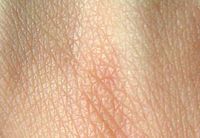
Photo from wikipedia
TiO2 nanoparticles known as E171 are one controversial food additive due to its potential toxicity. In this work, the main hypothesis is that the proteins adsorbed on the TiO2 nanoparticles… Click to show full abstract
TiO2 nanoparticles known as E171 are one controversial food additive due to its potential toxicity. In this work, the main hypothesis is that the proteins adsorbed on the TiO2 nanoparticles prevent their aggregation and favor the cell penetration. To do so, the TiO2 nanoparticles were coated with gelatin and β-lactoglobulin to reach interfacial concentrations about 0.25 mg/mg and 0.32 mg/mg, respectively. The measurement of NP size showed that the protein coating improve the colloidal stability of TiO2 nanoparticles. The FTIR analysis suggests that the β-lactoglobulin structure is modified after adsorption. The penetration of TiO2 penetration inside human intestinal epithelial cells was shown and quantify by using confocal Raman microscopy. The promoting role of the protein coating on the cell penetration was demonstrated for both the gelatin and β-lactoglobulin. Finally, the results allow establishing a correlation between the ability of proteins to prevent NP aggregation and the cell penetration.
Journal Title: Food chemistry
Year Published: 2021
Link to full text (if available)
Share on Social Media: Sign Up to like & get
recommendations!